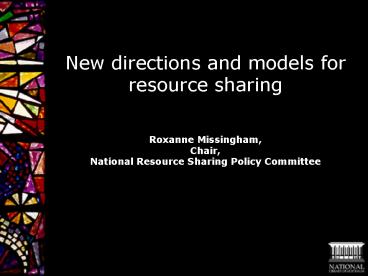New directions and models for resource sharing - PowerPoint PPT Presentation
1 / 21
Title:
New directions and models for resource sharing
Description:
New directions and models for resource sharing. Roxanne Missingham, Chair, ... Chair: Roxanne Missingham, National Library of Australia ... – PowerPoint PPT presentation
Number of Views:62
Avg rating:3.0/5.0
Title: New directions and models for resource sharing
1
New directions and models for resource
sharing Roxanne Missingham,Chair,National
Resource Sharing Policy Committee
2
New directions and models for resource sharing
- National Resource Sharing Working Group
- National Resource Sharing Policy Committee
- Resource sharing in Australia
- Resource sharing needs
- Proposal for a new service
3
National Resource Sharing Working Group Role
To ensure that a robust, reliable and
cost-effective interlending system, built on
cooperation and agreed service standards and
policies, is in place to serve Australian
libraries and their users
4
- National Resource Sharing Working Group
- Extend the current Australian Interlending Code
through development of performance standards . - Co-ordinate a consultative process with the
Australian library community on these standards. - Develop strategies to encourage Australian
libraries to implement performance standards.
5
National Resource Sharing Working Group Chair Dr
Toby Burrows, University of WA Ross Withnell,
State Library of Western Australia Christine
Cother, University of South Australia Margaret
Gauld, University of Queensland Annie Wall,
Maroochy Libraries Sharon Howells, University of
Newcastle Moyra McAllister, Blake Dawson
Waldron Mandy Bigg, National coordinator
GRATISNET, Central for Mental Health/Treatment,
Shannon Azarro, Monash University Gil Darby,
University of New South Wales Secretary Tom
Ruthven, National Library of Australia .
6
National Resource Sharing Policy Committee
Tole To address broad policy issues impacting
on inter-library loan and document delivery in
Australia and to provide support, guidance and
direction for the activities of the National
Resource Sharing Working Group.
7
National Resource Sharing Policy Committee Chair
Roxanne Missingham, National Library of
Australia Ross Withnell (Council of Australian
State Libraries) , State Library of Western
Australia Liz Curach (Committee of Australian
University Librarians) , University of Western
Sydney Sherrey Quinn (Australian Library and
Information Association) , Libraries Alive Pty
Ltd Dr Toby Burrows (National Resource Sharing
Working Group), University of Western Australia
Tom Ruthven, National Library of Australia
8
- Need for action
- Peak Bodies meeting in 2002
- Define a service model to ensure that individuals
can access information easily regardless of their
location
9
Resource Sharing in Australia Significant area
of library activity in Australia CAUL statistics
2001 304,834 copies and loans supplier to other
libraries 383,555 copies and loans received from
others Kinetica Document Delivery Service
2001/02 250,888 requests Increase of over 9 on
2000/01
10
Resource Sharing in Australia Level of activity,
costing of 12 per copy and loan Over 10 million
11
Resource sharing needs Importance to users This
library service provides people in the bush,
where I spend a fair amount of time, with an
opportunity to have the same service as city
dwellers with all the attendant appeal of
reading. The interlibrary loan system is
fantastic and means I am better able to keep up
to date, well informed etc and am more likely to
recommend others also go to their library first.
Keep up the good work.
12
Looking for books (Cantrell, 1999)
- Inter-library loans are of importance (for)
50 of the research being conducted in English
and Psychology in Australian universities. - 26.2 of English researchers had no problems
with current ill loan service. - 1 7.8 of Psychology researchers also had no
problems.
13
Looking for books
- Most commonly reported problems were
- cost (18.1 17.8),
- Speed (10.1 19.7) and
- Need to find better means of electronic access
to monographs and information about them (8
14.2).
14
Access to Scientific Journals in Australian
Libraries by Professor Neville Fletcher
- 48 of biologists but only 20 of physicists use
ill at least ten times per year. - Biologists were unhappy about the slowness of
ill services, and want electronic delivery of
requested articles. - Researchers in both fields cite delays of
several weeks in obtaining items on interlibrary
loan.
15
ALCTF Focus Groups
- Focus groups conducted at 5 Australian university
libraries - high dependence on electronic resources
- concerns about licensing restrictions which
prevent walk-in users accessing electronic
serials in universities with which they are not
affiliated - faster and cheaper access than standard
interlibrary loan is essential.
16
- Resource sharing needs
- Non-university scientists 0 11 readings from ILL
(Tenopir) - Importance of Australian collections, overlap
information Group of 8 - 56 of monograph titles are held in only one of
the eight libraries - 58 of serial titles are held in only one of the
major university research libraries
17
Models for resource sharing National regulated
model Borrow direct mediated supply Borrow
direct mediated service Centralised national
model
18
- A model for resource sharing
- Issues
- Accessibility for Australians
- Level of demand
- Costs of such a service
- Charging levels
19
A model for resource sharing Proposal for a pilot
to establish a collaborative project in
2003 Small number of participating
libraries Involving CAL Complementing the
National Librarys Copies direct and Kinetica
Public Libraries Portal pilot Need to share
information on other projects.
20
- Conclusion
- Australian libraries have resources which are
critical for research, learning, study and
community needs. - A cooperative framework has been established.
- A new collaboration approach will be trialed to
establish demand, costs and benefits - Further reports will be made at the IFLA ILDS
conference. In Canberra next October
21
www.nla.gov.au































